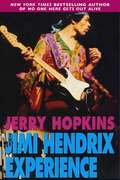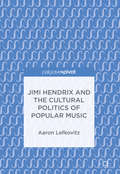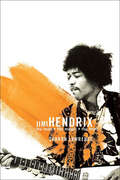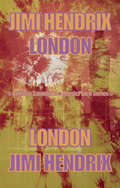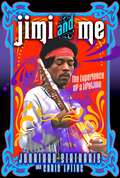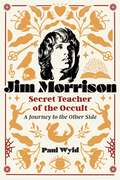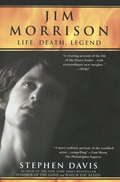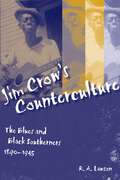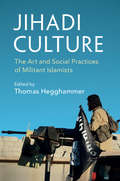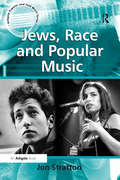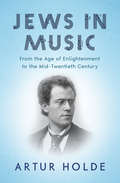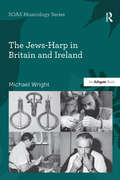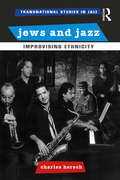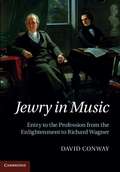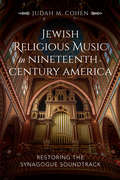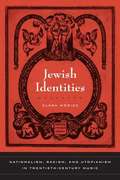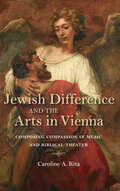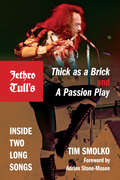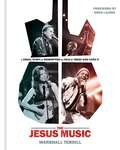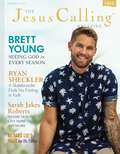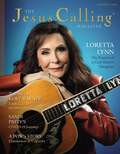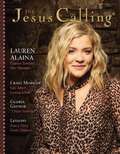- Table View
- List View
The Jimi Hendrix Experience
by Jerry HopkinsIt's been over forty years since the tragic death of Jimi Hendrix, yet his popularity is undiminished and his place as the preeminent electric guitarist of the ages is still unrivaled. In The Jimi Hendrix Experience, bestselling author and rock aficionado Jerry Hopkins delves into the legendary life and career of the greatest man to ever pick up a guitar. With a consistent mix of greatness and madness, learn why the man who only released three studio albums during his life could forever transform not only music, but also a generation. While he'll always be remembered for his incredible performance at Woodstock in 1969, Hopkins shows the true side of Hendrix: from his early childhood and the beginning of his career to his early death and the controversial battle of control over his estate that still wages on. With incredible photographs depicting Hendrix's rise to the top, The Jimi Hendrix Experience is the ultimate biography of the "Voodoo Chile." Hendrix's legacy and music will live on for generations to be enjoyed by and to live on with fans of all ages. And now, thanks to Hopkins, his life can be relived through this incredible biography.
Jimi Hendrix and the Cultural Politics of Popular Music
by Aaron LefkovitzThis book, on Jimi Hendrix’s life, times, visual-cultural prominence, and popular music, with a particular emphasis on Hendrix’s relationships to the cultural politics of race, gender, sexuality, ethnicity, class, and nation. Hendrix, an itinerant “Gypsy” and “Voodoo child” whose racialized “freak” visual image continues to internationally circulate, exploited the exoticism of his race, gender, and sexuality and Gypsy and Voodoo transnational political cultures and religion. Aaron E. Lefkovitz argues that Hendrix can be located in a legacy of black-transnational popular musicians, from Chuck Berry to the hip hop duo Outkast, confirming while subverting established white supremacist and hetero-normative codes and conventions. Focusing on Hendrix’s transnational biography and centrality to US and international visual cultural and popular music histories, this book links Hendrix to traditions of blackface minstrelsy, international freak show spectacles, black popular music’s global circulation, and visual-cultural racial, gender, and sexual stereotypes, while noting Hendrix’s place in 1960s countercultural, US-exceptionalist, cultural Cold War, and rock histories.
Jimi Hendrix: The Man, The Music, The Truth
by Sharon LawrenceThe genius we never understood. . . . The man we never knew. . . . The truth we never heard. . . . The music we never forgot. . . . A revealing portrait of a legend by a close and trusted friend.
Jimi Hendrix
by William SaundersDescribing how the city of London helped transform a little-known musician named Jimmy James into rock legend Jimi Hendrix, this revealing volume details how Hendrix helped transform London into a dynamo of popular music and social rebellion. The book examines Hendrix's impact on London's leading musicians-including the Beatles, the Rolling Stones, and Eric Clapton-and follows Hendrix as he acquires a savvy manager, a tight band, and a forgiving girlfriend and launches himself into a breakneck career that whisked him from dingy clubs to Woodstock and recording and television studios. Each chapter introduces unforgettable characters and takes readers on a trip through the psychedelic era, concluding with Hendrix's tragic death in a London apartment. It explores the public as well as the private man, capturing the contrast between the wild showman on stage and the unassuming guy behind the scenes.
Jimi and Me: The Experience of a Lifetime
by Jonathan StathakisA young screenwriter is invited to collaborate with Jimi Hendrix on a film, resulting in the wildest eighteen months of his life and coinciding with the tumultuous final months of Hendrix&’s life.In 1969, a twenty-something screenwriter with one movie credit to his name is approached by Jimi&’s management after the legendary guitarist saw the obscure indie film in London and had the idea to collaborate on a project of his own. Jonathan Stathakis had no idea how thrilling the next eighteen months would be, as he and Hendrix formed not just a working partnership but a unique friendship. Hendrix ushered Jonathan into his world, where plenty of sex and drugs surrounded the rock &’n&’ roll. From Woodstock to Electric Ladyland, Jonathan leads readers inside one of the craziest trips ever taken in music history. While writing their script, Jonathan and Hendrix talked about life and where their roads were leading. Hendrix the performer was a flamboyant unpredictable force of nature. But Hendrix the friend was a thoughtful, frustrated, dedicated artist who oftentimes just needed somebody to talk to. Sadly, Hendrix&’s journey ended far too soon, and his last phone call to Jonathan—just two days before his death in London—almost seemed to foretell his fate. With many never-before-told stories and never-before-seen photographs, Jimi Hendrix comes back to life as you&’ve never experienced him before. Backstage, on stage, and everyplace in between, get ready to ride through the purple haze and experience one of the most creative and powerful cultural eras in history. It&’s Almost Famous with a Hendrix twist.
Jim Morrison, Secret Teacher of the Occult: A Journey to the Other Side
by Paul Wyld• Reveals Jim Morrison as a shamanic initiate and esoteric teacher who used his role as a rock singer to promote the adventure of the spirit and express the power of inner experience• Examines Morrison&’s deep occult and artistic influences, including Kurt Seligmann&’s The Mirror of Magic, Colin Wilson&’s The Outsider, and the works of Jack Kerouac• Draws on Morrison&’s lyrics and poems, his intimate writings, and the recollections of friends like photographer Paul Ferrara and Doors keyboard player Ray ManzarekThe groundbreaking 1960s band The Doors, named for Aldous Huxley&’s The Doors of Perception, achieved incredible acclaim and influence, ultimately serving as a key group in the development of psychedelic and progressive rock. At the center of it all was front man Jim Morrison, who died in 1971 at age 27. Yet, as author Paul Wyld reveals, despite Morrison&’s reputation as a lewd, drunken performer, he was a full-fledged mystical, shamanic figure, a secret teacher of the occult who was not merely central to the development of rock music, but also to the growth of the Western esoteric tradition as a whole.Wyld looks at the mystical works that inspired Morrison, including Kurt Seligmann&’s The Mirror of Magic, Colin Wilson&’s The Outsider, and the writings of Nietzsche and Jack Kerouac. Drawing on Morrison&’s lyrics and poems, his intimate writings, and the recollections of friends like photographer Paul Ferrara and Doors keyboard player Ray Manzarek, the author makes the case that Morrison was not simply a superficial dabbler in the occult but an actual secret teacher transmitting knowledge through the golden thread stretching back to Egypt and Thoth-Hermes.Explaining how Morrison sought to use his role as a rock singer to express the power of inner experience, Wyld shows how praxis was at the heart of Morrison&’s approach, revealed in his journey through the arduous ordeals of shamanic initiation. He was a shaman, mystic, and sage—and an essential part of a great spiritual awakening to which he gave himself over fully.
Jim Morrison: LIfe, Death, Legend
by Stephen DavisAs the lead singer of the Doors, Jim Morrison's searing poetic vision and voracious appetite for sexual, spiritual, and psychedelic experience inflamed the spirit and psyche of a generation. Since his mysterious death in 1971, millions more fans from a new generation have embraced his legacy, as layers of myth have gathered to enshroud the life, career, and true character of the man who was James Douglas Morrison.<P> In Jim Morrison, critically acclaimed journalist Stephen Davis, author of Hammer of the Gods, unmasks Morrison's constructed personas of the Lizard King and Mr. Mojo Risin' to reveal a man of fierce intelligence whose own destructive tendencies both fueled his creative ambitions and brought about his downfall. Gathered from dozens of original interviews and investigations of Morrison's personal journals, Davis has assembled a vivid portrait of a misunderstood genius, tracing the arc of Morrison's life from his troubled youth to his international stardom, when his drug and alcohol binges, tumultuous sexual affairs, and fractious personal relationships reached a frenzied peak. For the first time, Davis is able to reconstruct Morrison's last days in Paris to solve one of the greatest mysteries in music history in a shocking final chapter.<P> Compelling and harrowing, intimate and revelatory, Jim Morrison is the definitive biography of the rock idol in snakeskin and leather who defined the 1960s.
Jim Marshall: Images and Stories from a Photography Legend
by Amelia DavisJim Marshall created iconic images of rock 'n' roll stars, jazz greats, and civil rights leaders. He had the power to look into the soul of an individual and to capture the mood of an entire generation. This deluxe, career-spanning volume showcases hundreds of photographs: intimate portraits, heady crowd scenes, and haunting street shots evoking the sights and sounds of the 1960s and 1970s. Marked-up proof sheets offer insight into Marshall's process, while in-depth essays from his contemporaries tell a compelling story about this larger-than-life man. Nearly a decade after his death, Marshall's legacy is the subject of a documentary feature film.
Jim Crow's Counterculture: The Blues and Black Southerners, 1890-1945 (Making the Modern South)
by R. A. LawsonIn the late nineteenth century, black musicians in the lower Mississippi Valley, chafing under the social, legal, and economic restrictions of Jim Crow, responded with a new musical form -- the blues. In Jim Crow's Counterculture, R. A. Lawson offers a cultural history of blues musicians in the segregation era, explaining how by both accommodating and resisting Jim Crow life, blues musicians created a counterculture to incubate and nurture ideas of black individuality and citizenship. These individuals, Lawson shows, collectively demonstrate the African American struggle during the early twentieth century. Derived from the music of the black working class and popularized by commercially successful songwriter W. C. Handy, early blues provided a counterpoint to white supremacy by focusing on an anti-work ethic that promoted a culture of individual escapism -- even hedonism -- and by celebrating the very culture of sex, drugs, and violence that whites feared. According to Lawson, blues musicians such as Charley Patton and Muddy Waters drew on traditions of southern black music, including call and response forms, but they didn't merely sing of a folk past. Instead, musicians saw blues as a way out of economic subservience. Lawson chronicles the major historical developments that changed the Jim Crow South and thus the attitudes of the working-class blacks who labored in that society. The Great Migration, the Great Depression and New Deal, and two World Wars, he explains, shaped a new consciousness among southern blacks as they moved north, fought overseas, and gained better-paid employment. The "me"-centered mentality of the early blues musicians increasingly became "we"-centered as these musicians sought to enter mainstream American life by promoting hard work and patriotism. Originally drawing the attention of only a few folklorists and music promoters, popular black musicians in the 1940s such as Huddie Ledbetter and Big Bill Broonzy played music that increasingly reached across racial lines, and in the process gained what segregationists had attempted to deny them: the identity of American citizenship.By uncovering the stories of artists who expressed much in their music but left little record in traditional historical sources, Jim Crow's Counterculture offers a fresh perspective on the historical experiences of black Americans and provides a new understanding of the blues: a shared music that offered a message of personal freedom to repressed citizens.
Jihadi Culture: The Art and Social Practices of Militant Islamists
by Thomas HegghammerAl-Qaida and Islamic State continue to captivate the world with their extreme violence. While much attention has been given to the operations and doctrines of jihadi groups, this is the first book to explore their culture. Using a wealth of primary sources, the authors examine what goes on inside these organizations and what daily life is like for the foot-soldiers. They show that Islamist militants have a rich aesthetic culture and do much more than fight and train. Life in a jihadi group is in fact filled with poetry and music, and fighters spend time on surprising things like dream interpretation and weeping. Readers will discover an entirely new perspective on radical Islamists: that despite their reputation as macho men, they value humility, artistic sensitivity, and displays of emotion. Cultural practices are essential for understanding the jihadi worldview and may shed important new light on decision-making and recruitment processes in extremist groups. This original book will interest anyone in academia, government, or the general public who is intrigued by the appeal and resilience of the jihadi movement.
Jews, Race and Popular Music (Ashgate Popular And Folk Music Ser.)
by Jon StrattonJon Stratton provides a pioneering work on Jews as a racialized group in the popular music of America, Britain and Australia during the twentieth and early twenty-first centuries. Rather than taking a narrative, historical approach the book consists of a number of case studies, looking at the American, British and Australian music industries. Stratton's primary motivation is to uncover how the racialized positioning of Jews, which was sometimes similar but often different in each of the societies under consideration, affected the kinds of music with which Jews have become involved. Stratton explores race as a cultural construction and continues discussions undertaken in Jewish Studies concerning the racialization of the Jews and the stereotyping of Jews in order to present an in-depth and critical understanding of Jews, race and popular music.
Jews in Music: From the Age of Enlightenment to the Mid-Twentieth Century
by Artur HoldeThis authoritative history chronicles the work and lives of great Jewish musicians around the world from the early nineteenth century to the mid-twentieth. Since the Age of Enlightenment, Jewish musicians, composers, and musicologists have greatly enriched the artistic legacies of cultures and countries on a global scale. Their contributions have been a major influence on numerous musical forms, both secular and sacred. Jews in Music presents a survey of these accomplishments through the rise of Zionism, the settlement of the Jewish Homeland, and the burgeoning Jewish music developments in America.Jews in Music presents a detailed history ranging from the symphonies of Felix Mendelssohn to the Broadway musicals of Leonard Bernstein, from the great touring violinists of Western Europe to the pioneers of commercial music recording. Plus, a section on sacred music explores in depth the evolution of the musical components of the synagogue, including the chants, compositions, and traditional songs of the chazzanim.
The Jews-Harp in Britain and Ireland (Soas Studies In Music Ser.)
by Michael WrightThe jews-harp is a distinctive musical instrument of international importance, yet it remains one of those musical instruments, like the ocarina, kazoo or even the art of whistling, that travels beneath the established musical radar. The story of the jews-harp is also part of our musical culture, though it has attracted relatively little academic study. Britain and Ireland played a significant role in the instrument�s manufacture and world distribution, particularly during the nineteenth and first half of the twentieth centuries. Drawing upon previously unknown written sources and piecing together thousands of fragments of information spanning hundreds of years, Michael Wright tells the story of the jews-harp�s long history in the Britain and Ireland. Beginning with an introductory chapter describing the instrument, Part One looks at the various theories of its ancient origin, how it came to be in Europe, terminology, and its English name. Part Two explores its commercial exploitation and the importance of the export market in the development of manufacturing. Part Three looks the instrument�s appearance and use in art, literature and the media, finally considering the many players who have used the instrument throughout its long history.
Jews and Jazz: Improvising Ethnicity
by Charles B HerschJews and Jazz: Improvising Ethnicity explores the meaning of Jewish involvement in the world of American jazz. It focuses on the ways prominent jazz musicians like Stan Getz, Benny Goodman, Artie Shaw, Lee Konitz, Dave Liebman, Michael Brecker, and Red Rodney have engaged with jazz in order to explore and construct ethnic identities. The author looks at Jewish identity through jazz in the context of the surrounding American culture, believing that American Jews have used jazz to construct three kinds of identities: to become more American, to emphasize their minority outsider status, and to become more Jewish. From the beginning, Jewish musicians have used jazz for all three of these purposes, but the emphasis has shifted over time. In the 1920s and 1930s, when Jews were seen as foreign, Jews used jazz to make a more inclusive America, for themselves and for blacks, establishing their American identity. Beginning in the 1940s, as Jews became more accepted into the mainstream, they used jazz to "re-minoritize" and avoid over-assimilation through identification with African Americans. Finally, starting in the 1960s as ethnic assertion became more predominant in America, Jews have used jazz to explore and advance their identities as Jews in a multicultural society.
Jewry in Music
by David ConwayDavid Conway analyses why and how Jews, virtually absent from Western art music until the end of the eighteenth century, came to be represented in all branches of the profession within fifty years as leading figures - not only as composers and performers, but as publishers, impresarios and critics. His study places this process in the context of dynamic economic, political, sociological and technological changes and also of developments in Jewish communities and the Jewish religion itself, in the major cultural centres of Western Europe. Beginning with a review of attitudes to Jews in the arts and an assessment of Jewish music and musical skills, in the age of the Enlightenment, Conway traces the story of growing Jewish involvement with music through the biographies of the famous, the neglected and the forgotten, leading to a new and radical contextualisation of Wagner's infamous 'Judaism in Music'.
Jewish Religious Music in Nineteenth-Century America: Restoring the Synagogue Soundtrack
by Judah M. CohenThis study of synagogue music in the United States in the second half of the nineteenth century “sets a high standard for historical musicology” (Musica Judaica).In Jewish Religious Music in Nineteenth-Century America: Restoring the Synagogue Soundtrack, Judah M. Cohen demonstrates that Jews constructed a robust religious musical conversation in the United States during the mid- to late-nineteenth century. While previous studies of American Jewish music history have looked to Europe as a source of innovation during this time, Cohen’s careful analysis of primary archival sources tells a different story. Far from seeing a fallow musical landscape, Cohen finds that Central European Jews in the United States spearheaded a major revision of the sounds and traditions of synagogue music during this period of rapid liturgical change.Focusing on the influences of both individuals and texts, Cohen demonstrates how American Jewish musicians sought to balance artistry and group singing, rather than “progressing” from solo chant to choir and organ. Congregations shifted between musical genres and practices during this period in response to such factors as finances, personnel, and communal cohesiveness. Cohen concludes that the “soundtrack” of nineteenth-century Jewish American music heavily shapes how we look at Jewish American music and life in the first part of the twenty-first century, arguing that how we see, and especially hear, history plays a key role in our understanding of the contemporary world around us. Supplemented with an interactive website that includes the primary source materials, recordings of the music discussed, and a map that highlights the movement of key individuals, Cohen’s research defines more clearly the sound of nineteenth-century American Jewry.
Jewish Identities: Nationalism, Racism, and Utopianism in Twentieth-Century Music
by Klara MoriczKlara Moricz scrutinizes concepts of Jewish identity and reorders ideas about twentieth-century "Jewish music" in three case studies: first, Russian Jewish composers of the first two decades of the twentieth century; second, the Swiss American Ernest Bloch; and third, Arnold Schoenberg.
Jewish Difference and the Arts in Vienna: Composing Compassion in Music and Biblical Theater (German Jewish Cultures)
by Caroline A KitaDuring the mid-19th century, the works of Arthur Schopenhauer and Richard Wagner sparked an impulse toward German cultural renewal and social change that drew on religious myth, metaphysics, and spiritualism. The only problem was that their works were deeply antisemitic and entangled with claims that Jews were incapable of creating compassionate art. By looking at the works of Jewish composers and writers who contributed to a lively and robust biblical theatre in fin de siècle Vienna, Caroline A. Kita shows how they reimagined myths of the Old Testament to offer new aesthetic and ethical views of compassion. These Jewish artists, including Gustav Mahler, Siegfried Lipiner, Richard Beer-Hofmann, Stefan Zweig, and Arnold Schoenberg, reimagined biblical stories through the lens of the modern Jewish subject to plead for justice and compassion toward the Jewish community. By tracing responses to antisemitic discourses of compassion, Kita reflects on the explicitly and increasingly troubled political and social dynamics at the end of the Habsburg Empire.
The Jewish Cultural Tapestry: International Jewish Folk Traditions
by Steven M. LowensteinFilled with fascinating facts and keen insights, The Jewish Cultural Tapestry is a richly woven fabric that vividly captures the diversity of Jewish life. All traditional Jews are bound together by the common thread of the Torah and the Talmud, notes author Steven Lowenstein, but this thread takes on a different coloration in different parts of the world as Jewish tradition and local non-Jewish customs intertwine. Lowenstein describes these widely varying regional Jewish cultures with needlepoint accuracy, highlighting the often surprising similarities between Jewish and non-Jewish local traditions, and revealing why Jewish customs vary as much as they do from region to region. From Europe to India, Israel to America, The Jewish Cultural Tapestry offers an engaging overview of the customs and folkways of a people united by tradition, yet scattered to the far corners of the earth.
Jethro Tull's Thick as a Brick and A Passion Play
by Tim SmolkoSince the 1960s, British progressive rock band Jethro Tull has pushed the technical and compositional boundaries of rock music by infusing its musical output with traditions drawn from classical, folk, jazz, and world music. The release of Thick as a Brick (1972) and A Passion Play (1973) won the group legions of new followers and topped the Billboard charts in the United States, among the most unusual albums ever to do so. Tim Smolko explores the large-scale form, expansive instrumentation, and complex arrangements that characterize these two albums, each composed of one continuous song. Featuring insights from Ian Anderson and in-depth musical analysis, Smolko discusses the band's influence on popular culture and why many consider Thick as a Brick and A Passion Play to be two of the greatest concept albums in rock history.
The Jesus Music: A Visual Story of Redemption as Told by Those Who Lived It
by Marshall TerrillA written and visual complement to the documentary film of the same name, The Jesus Music brings the history of a movement to life. Featuring Contemporary Christian Music artists across five decades, readers will experience the story that has united and changed the lives of people around the world. The Jesus Music: A Visual Story of Redemption as Told by Those Who Lived It shares that story: people creating something they wanted, something that never existed before. Written by music and film historian Marshall Terrill, the book accompanies a documentary film by award-winning directors Jon and Andy Erwin; this written and visual narrative of the genre features historic concerts and candid behind-the-scenes photographs throughout. The Jesus Music explores the history, evolution, and redemptive thread of Contemporary Christian music over the last fifty years as it spans the convergence of rock and roll, country, and gospel music. As CCM grows, readers will see California artists as much a part of hippie culture as Christian culture, religious-focused bands and songs denounced by some church leaders of the day, and best-selling artists who rose, and sometimes fell from fame, as they journey through the music and experience the often delicate balances between faith, fame, mission, and humanity as they relate to Christian music. The notable voices of Amy Grant, Michael W. Smith, Kirk Franklin, and TobyMac, as well as the stories of dozens of additional Christian artists, will hit all the right notes and explore: - The roots of the movement, spanning from Elvis Presley and Johnny Cash to Switchfoot, Chris Tomlin, Hillsong United, and beyond. - The stories of pioneers in the genre, including Larry Norman, Lovesong, and Stryper - Insights into how history, culture, and technology shaped the Contemporary Christian music we hear on the radio today. - Examples of God&’s steadfast love as He uses artists despite their human mistakes and shortcomings. - How the message of the music transforms lives and has impact beyond artistic expression. The Jesus Music is perfect for anyone looking to explore the history of the genre and discover how God can use us despite our flaws to impact the world.
The Jesus Lizard Book
by The Jesus LizardFeatured as a "This Week's Reading/What We're Loving" pick at The Paris ReviewNamed the Best Music-Related Book of 2014 by Joel Gausten"If you're a Jesus Lizard fan or a David Yow devotee, you're sure all over this. But even if you've never heard of the band, the book stands as one of the best ways to experience being in a tight, cohesive band. You get everything except the sweat, spilled beer, and blood. It's a fun ride, and the closest thing possible to getting in the van with these guys."--Mother Jones"The Jesus Lizard Book is a beautiful document of a band that wasn't afraid to be abrasive, chaotic, brutal, and sometimes, ugly."--The Chicago Tribune/Printers Row"These guys deserve to pat themselves on the back...If the spectacular photography in The Jesus Lizard Book is to be believed, their shows resembled nothing more than that scene in Indiana Jones and the Temple of Doom where some poor dude has his still-beating heart removed in an elaborate ritual."--The Paris Review"As a reader, you don’t need to hear the songs to appreciate the story--and Book delivers the band right to your coffee table loud and clear."--BoingBoing.net"The gorgeously crafted, 176-page hardcover Book...dives deep and candidly into the Jesus Lizard's first decade and touches a bit on that 2009 coda, too. Through many thousands of words, hundreds of photos, and collected ephemera, it celebrates the sweat, menace, humor, musicianship, lasting power, and genitals of one of the best bands ever coughed up by the rock underground."--The Village Voice"Book is a valuable document that brings us back to the era when artists were conditioned to practice the art of self-defense."--Pitchfork"A series of essays and photos that illuminates the Jesus Lizard--humorous, jolting, sometimes surprisingly moving."--The Chicago Tribune"If there is any recurring theme within the 176 pages of the newly released The Jesus Lizard Book it's this: The Chicago-grown noise rockers will be remembered as one of the greatest live bands to ever grace--or very well desecrate--the stage."--Chicago Sun-Times"Impressively candid, informed and informative history of a remarkable group of musicians. A 'must read' for their legions of appreciative fans...Highly recommended."--Midwest Book Review"Even if you're unfamiliar with or disinterested with the band's music, Book makes for an intriguing exploration of the alternative music scene of the '90s--a short burst in time when a band as gloriously odd as The Jesus Lizard could do whatever they wanted to do and get a pot of gold at the end of the rainbow."--Joel GaustenThe Jesus Lizard Book is a coffee table affair of exclusive photography, art, and other imagery with written pieces by all four members of the seminal indie rock band the Jesus Lizard. The layout is stylish and elegant, particularly in contrast with the harshness of much of the band's music. Included are many Polaroids by David Wm. Sims, a delicious recipe by David Yow, a concise list of every show the Jesus Lizard played, and writings by two producers who recorded the band--Steve Albini and Andy Gill. There is biographical material of each member that covers childhood to the demise of the group. Other contributors include, Mike Watt, Alexander Hacke, Steve Gullick, Rebecca Gates, Jeff Lane, Sasha Frere-Jones, KRK, Bernie Bahrmasel, and many more.
The Jesus Calling Magazine Issue 8: Brett Young (The Jesus Calling Magazine)
by Sarah YoungThis edition of The Jesus Calling Magazine features an interview with country music superstar and author Brett Young sharing how he sees God working in every chapter of his life; assuring words from author Sarah Jakes Roberts on how shame cannot define us--only God can; a close look at how pro skateboarder Ryan Sheckler has found his spiritual footing; and the moving story of how TV news anchor Richard Lui became a committed caretaker of his father when he was diagnosed with Alzheimer's Disease.The Jesus Calling Magazine is a companion resource to Sarah Young's New York Times bestselling devotional, which has impacted the lives of more than 40 million people. These stories of hope will inspire you and equip you with tools to strengthen your relationships with family, friends, and yourself.The Jesus Calling Magazine will encourage you through:Interviews with well-known artists, authors, and entertainers"Doing Good" feature, spotlighting non-profits and everyday heroes serving their community in the name of ChristMusic spotlight showcasing musicians and performers using their gifts for God's gloryPastor's Corner with inspiration words from leading Christian teachersEntertaining puzzles and games for the familyRead additional issues of The Jesus Calling Magazine and look for more life-changing, life-giving books from Sarah Young, including:Jesus ListensJesus AlwaysJesus Today
The Jesus Calling Magazine Issue 4: Loretta Lynn (The Jesus Calling Magazine)
by Sarah YoungThis edition of The Jesus Calling Magazine features an interview with GRAMMY award-winning, country music icon Loretta Lynn sharing how prayer has carried her through her life; the secret code that saved veteran and POW Carlyle "Smitty" Harris's life; NFL quarterback Kurt Warner's story of how he found God during the trials on his path to the NFL; and the COVID-19 recovery story of GRAMMY Award-winning artist Sandi Patty.The Jesus Calling Magazine is a companion resource to Sarah Young's New York Times bestselling devotional, which has impacted the lives of more than 40 million people. These stories of hope will inspire you and equip you with tools to strengthen your relationships with family, friends, and yourself.The Jesus Calling Magazine will encourage you through:Interviews with well-known artists, authors, and entertainers"Doing Good" feature, spotlighting non-profits and everyday heroes serving their community in the name of ChristMusic spotlight showcasing musicians and performers using their gifts for God's gloryPastor's Corner with inspiration words from leading Christian teachersEntertaining puzzles and games for the familyRead additional issues of The Jesus Calling Magazine and look for more life-changing, life-giving books from Sarah Young, including:Jesus ListensJesus AlwaysJesus Today
The Jesus Calling Magazine Issue 3: Lauren Alaina (The Jesus Calling Magazine)
by Sarah YoungThis edition of The Jesus Calling Magazine features an interview with country music artist Lauren Alaina who shares how living the dream also means enduring the pain of the spotlight; four ways to help kids cultivate one big heart by journalist Linsey Davis; co-founder of Saddleback Church, Kay Warren, helping others redefine joy when tragedy strikes; and the powerful faith story of country music star Craig Morgan who found strength in God when facing the loss of his son.The Jesus Calling Magazine is a companion resource to Sarah Young's New York Times bestselling devotional, which has impacted the lives of more than 40 million people. These stories of hope will inspire you and equip you with tools to strengthen your relationships with family, friends, and yourself.The Jesus Calling Magazine will encourage you through:Interviews with well-known artists, authors, and entertainers"Doing Good" feature, spotlighting non-profits and everyday heroes serving their community in the name of ChristMusic spotlight showcasing musicians and performers using their gifts for God's gloryPastor's Corner with inspiration words from leading Christian teachersEntertaining puzzles and games for the familyRead additional issues of The Jesus Calling Magazine and look for more life-changing, life-giving books from Sarah Young, including:Jesus ListensJesus AlwaysJesus Today
